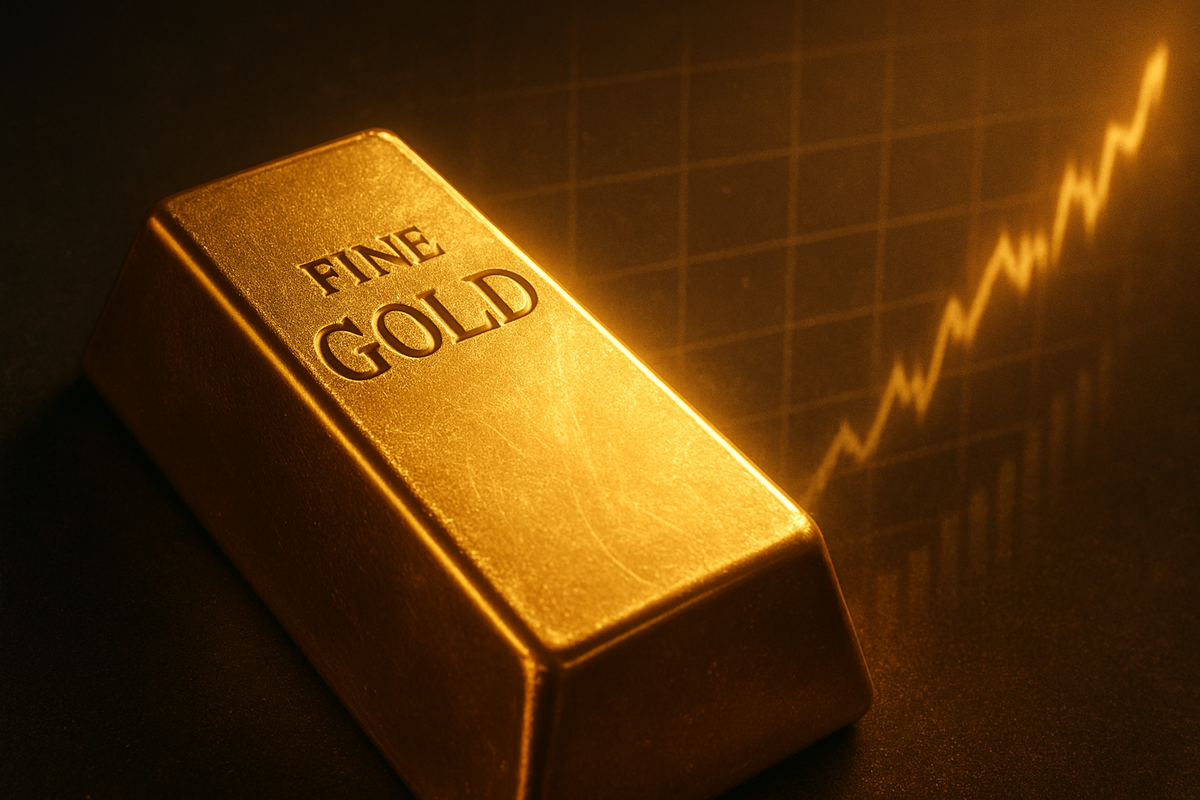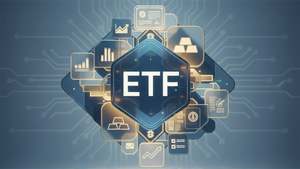
In a remarkable display of financial resilience, gold prices have not only sustained but strengthened their position near the unprecedented $4,000 per ounce level as of October 10, 2025. This historic surge, which saw the precious metal touch an all-time high of $4,078 earlier this week, signifies more than just a commodity rally; it reflects a profound recalibration of investor sentiment in the face of persistent global economic and geopolitical uncertainties. Despite sporadic bearish reactions and profit-taking, gold's steadfast performance underscores its enduring role as a critical safe-haven asset and a barometer of deeper market anxieties.
This sustained strength, representing an astonishing gain of over 50% year-to-date in 2025 and marking its biggest rally since the 1970s, is forcing investors and institutions alike to reassess traditional portfolio strategies. With the U.S. dollar weakening, fiscal deficits widening, and de-dollarization trends gaining momentum, gold is increasingly viewed as an indispensable hedge against inflation and a tangible store of value in an unpredictable world.
Gold's Historic Ascent: A Deep Dive into the $4,000 Breakthrough
Gold's journey to and beyond the $4,000 per ounce threshold has been swift and decisive, culminating in an all-time high of $4,078 on October 8, 2025, and maintaining a robust position around $3,967 to $3,995 on October 10, despite minor profit-taking. This extraordinary rally is not merely a fleeting market anomaly but the result of a complex interplay of systemic factors that have been brewing for months, if not years. The precious metal's resilience, even in the face of short-term pullbacks, highlights an underlying conviction among investors about its intrinsic value in the current economic climate.
The timeline leading up to this moment reveals a steady accumulation of pressures. Throughout 2024 and into 2025, a confluence of escalating geopolitical tensions—including an ongoing U.S. government shutdown, political unrest in key European nations, and the lingering impacts of trade protectionism—has stoked global anxiety. Simultaneously, persistent inflation concerns, despite central bank efforts, have eroded confidence in fiat currencies, pushing investors towards tangible assets. This sentiment has been further amplified by expectations of future interest rate cuts by the Federal Reserve, which diminish the opportunity cost of holding non-yielding gold and tend to weaken the U.S. dollar, making gold cheaper for international buyers.
Key players driving this gold surge extend beyond individual investors. Central banks globally have emerged as significant stakeholders, actively and consistently increasing their gold reserves as a strategic diversification away from U.S. dollar holdings. Nations such as China, Poland, Türkiye, and India have been particularly notable in their aggressive gold accumulation, signaling a broader shift in international reserve allocations. This institutional buying provides a strong floor for gold prices, bolstering its stability. Furthermore, broad-based investor demand, spanning institutional, retail, and high-net-worth individuals, has created significant "fear-of-missing-out" (FOMO) flows into physical gold and gold-backed Exchange Traded Funds (ETFs), drawing new capital into the market.
Initial market reactions have been characterized by a mix of awe and strategic recalibration. While some traditional analysts initially viewed gold's ascent with skepticism, its sustained strength near $4,000 has forced a widespread acknowledgment of its fundamental drivers. Financial institutions like Goldman Sachs (NYSE: GS), ING, J.P. Morgan (NYSE: JPM), and UBS (SWX: UBSG) have all revised their forecasts upwards, with some projecting gold to reach nearly $4,900 per ounce by late 2025 or 2026. This consensus shift underscores a recognition that gold's rally is indicative of deeper structural issues within the global financial system, rather than a speculative bubble. The market is now actively pricing in gold's role as a primary hedge against systemic risks and a reliable store of wealth amidst increasing policy credibility concerns and economic uncertainty.
Corporate Fortunes Shift: Winners and Losers in a $4,000 Gold Market
The sustained ascent of gold prices to near $4,000 per ounce has dramatically reshaped the financial landscape, creating clear winners and losers across various public sectors. Companies directly involved in gold production, streaming, and investment are reaping substantial benefits, while those reliant on gold as a raw material face significant margin pressures and strategic challenges.
The most immediate beneficiaries are the gold mining companies. With their all-in sustaining costs (AISC) remaining relatively stable, the surge in gold prices translates directly into significantly expanded profit margins and robust cash flows. This windfall makes previously marginal projects economically viable and stimulates increased exploration and development activities. Industry giants like Newmont Corporation (NYSE: NEM), the world's largest gold producer, and Barrick Gold Corporation (NYSE: GOLD) are experiencing a substantial boost to their profitability. Newmont, for instance, has already seen its Ahafo North Project in Ghana achieve its first gold pour, with operations poised to capitalize on these elevated prices. Similarly, Agnico Eagle Mines Limited (NYSE: AEM) and Fresnillo (LSE: FRES), a major gold and silver producer, are seeing their financial outlooks brighten considerably. Junior exploration companies such as Integra Resources, with its cash-generating Florida Canyon Mine and promising DeLamar Project, are also finding their assets dramatically revalued, attracting fresh investment and potential acquisition interest.
Gold streaming and royalty companies are also experiencing a significant uplift. These firms, which provide upfront capital to miners in exchange for future gold production at predetermined, low prices, see their margins widen dramatically without incurring direct operational costs or risks. Wheaton Precious Metals Corp. (NYSE: WPM) and Franco-Nevada (NYSE: FNV), two leaders in this space, are perfectly positioned to capitalize on the current price environment, with their revenue and shareholder value poised for substantial growth. Furthermore, gold-backed Exchange-Traded Funds (ETFs) and their issuers are witnessing record inflows, directly increasing their Assets Under Management (AUM). Funds like SPDR Gold Shares (NYSEARCA: GLD) and iShares Gold Trust (NYSEARCA: IAU) have seen their net assets swell, benefiting investors and generating higher management fees for their operators.
Conversely, industries where gold is a primary raw material are facing considerable headwinds. Jewelry manufacturers and retailers are grappling with significantly increased production costs. Companies like India's Titan Company Ltd. (NSE: TITAN) and Kalyan Jewellers India Ltd. (NSE: KALYANJWL) are confronting the challenge of passing these higher costs onto consumers, which can deter price-sensitive buyers and lead to reduced sales volumes. Crisil, for instance, predicts a 9-11% drop in sales volume for organized gold jewelry retailers in India in FY26. This pressure is prompting strategic adaptations, including the promotion of minimalist designs, increased focus on gold recycling, and the exploration of alternative materials, a trend also observed among French jewelry and watchmaking companies.
The luxury goods sector, particularly hard luxury segments like watches and high-end jewelry, is also feeling the pinch. European luxury conglomerates such as LVMH (EPA: LVMH) and Richemont (SWX: CFR), which own numerous prestigious watch and jewelry brands, face rising input costs. While ultra-wealthy consumers may be less price-sensitive, sustained high prices, potentially exacerbated by currency fluctuations like a weaker U.S. dollar against the Euro, could impact overall demand and sales for some brands, particularly those with less pricing power. Beyond luxury, high-tech electronics companies that utilize gold in their components may also experience increased input costs, potentially squeezing margins if these cannot be effectively passed on to consumers. Lastly, while less prevalent in a bull market, any gold mining companies that engaged in aggressive hedging strategies at significantly lower prices could effectively lose out on the full benefits of the current price surge, missing out on potential windfall profits.
Wider Significance: Gold as a Bellwether of Global Shifts
Gold's sustained strength above $4,000 per ounce is more than a simple commodity price surge; it is a profound indicator of shifting global economic paradigms and geopolitical anxieties. This rally fits squarely into broader industry trends emphasizing diversification away from traditional assets and a renewed focus on tangible stores of value amidst pervasive uncertainty. The current environment mirrors historical precedents where gold has served as the ultimate safe haven, signaling a fundamental re-evaluation of risk and stability in the global financial architecture.
One of the most significant broader trends is the accelerated de-dollarization movement and the diversification strategies of central banks. Nations are increasingly wary of over-reliance on the U.S. dollar for their reserves, driven by geopolitical tensions, the weaponization of sanctions, and concerns over U.S. fiscal health. The record central bank buying, particularly from countries like China, India, and Poland, is not just about hedging inflation but about strategic autonomy and reducing systemic risk exposure. This trend has significant ripple effects on currency markets, potentially weakening the dollar's long-term dominance and influencing the reserve allocations of other nations, which might consider increasing their gold holdings or exploring other precious metals.
The persistent inflationary pressures and concerns about central bank independence also play a crucial role. Despite efforts to control inflation, the market seems to be signaling a lack of full confidence in the long-term effectiveness of current monetary policies. Gold, with its historical role as an inflation hedge, becomes increasingly attractive when real interest rates are low or negative, and the purchasing power of fiat currencies is perceived to be eroding. This also implies potential ripple effects on fixed-income markets, as investors may seek alternatives to bonds that are struggling to keep pace with inflation.
From a regulatory and policy perspective, gold's surge could prompt governments and international bodies to re-examine financial stability frameworks. A rapidly appreciating gold market, driven by distrust in traditional financial systems, could highlight vulnerabilities or necessitate new approaches to managing global economic stability. While direct regulatory interventions on gold prices are unlikely, the underlying conditions driving its rise—such as high fiscal deficits and geopolitical instability—are firmly within the purview of policymakers. The ongoing U.S. government shutdown, mentioned in earlier research, is a prime example of domestic policy failures contributing to global uncertainty and, by extension, gold's appeal.
Historically, gold has always performed strongly during periods of significant global upheaval. Comparisons can be drawn to the oil crises of the 1970s, which saw gold's last major rally, or periods of intense geopolitical tension during the Cold War. In each instance, gold acted as a refuge from economic instability and political uncertainty. The current environment, characterized by a complex mix of geopolitical conflicts, economic slowdown fears, and unprecedented levels of national debt, presents a similar, if not more intricate, landscape. Gold's sustained strength near $4,000 is therefore not an isolated event but a powerful symptom of deep-seated anxieties and a fundamental shift in how value and security are perceived in an increasingly unpredictable world. It underscores a growing distrust in traditional financial assets and government economic policies, positioning gold as a critical asset for hedging against systemic risks.
What Comes Next: Navigating Gold's Bullish Horizon
As gold firmly entrenches itself near the $4,000 per ounce mark, the financial world is keenly observing its future trajectory, which appears to be overwhelmingly bullish in both the short and long term. This sustained strength necessitates strategic pivots from market participants and presents a unique blend of opportunities and challenges.
In the short-term (next 0-12 months), the consensus among analysts points to continued upward momentum, albeit with potential for minor profit-taking corrections. Forecasts from J.P. Morgan Research anticipate gold to average around $3,675/oz by Q4 2025, rising towards $4,000/oz by Q2 2026, while more aggressive projections eye $4,500-$5,000 for late 2025 to early 2026. This near-term strength is underpinned by persistent geopolitical uncertainties, including ongoing regional conflicts and trade policy shifts, which continue to fuel safe-haven demand. Crucially, the Federal Reserve's anticipated pivot towards monetary easing and further interest rate cuts will reduce the opportunity cost of holding non-yielding gold, making it increasingly attractive. A weakening U.S. dollar further enhances gold's appeal for international buyers.
Looking further out into the long-term (beyond 12 months), the trajectory for gold remains robustly bullish, driven by fundamental shifts in the global economic and financial landscape. InvestingHaven projects maximum gold prices of around $4,200 in 2026, $4,800 in 2027, and potentially $5,455 by 2030, with Goldman Sachs (NYSE: GS) anticipating $4,900 per ounce by the end of 2026. These optimistic outlooks are rooted in persistent inflation concerns, the ongoing debasement of fiat currencies due to increasing national debts, and the critical role gold plays as a hedge against systemic risks. The continued de-dollarization trend and central bank diversification away from the U.S. dollar are structural drivers that will provide long-term support. Randy Smallwood, CEO of Wheaton Precious Metals Corp. (NYSE: WPM), aptly summarizes this sentiment, foreseeing a "golden future" for the metal through the end of the decade.
Strategic pivots are essential for various market participants. Investors are urged to re-evaluate their asset allocations, potentially increasing their gold exposure beyond traditional levels to 5-10% or more, viewing it as a strategic hedge rather than a tactical trade. Gold mining companies, buoyed by higher profitability, are likely to accelerate exploration efforts and bring new projects online to capitalize on elevated prices. Streaming and royalty companies will intensify their search for high-quality assets. Even industrial users, such as electronics manufacturers, might monetize existing precious metal inventories at record highs to unlock capital. Central banks, meanwhile, are expected to continue, or even increase, their gold purchases as a key component of reserve diversification.
Emerging market opportunities and challenges will also shape gold's future. These markets, particularly China, India, and Turkey, represent nearly three-quarters of global consumer demand over the past decade, driven by economic conditions and cultural affinity. Gold-producing emerging economies stand to benefit significantly from increased export revenues and stronger current accounts. However, high gold prices can challenge local jewelry and manufacturing sectors in these regions, necessitating adaptive strategies. Potential scenarios range from a sustained bull market, which is highly probable given current drivers, to a moderate correction followed by a resumption of the uptrend. While a "black swan" event could trigger an even more dramatic rally, a significant downturn is considered a low probability given the fundamental shifts supporting gold's current strength.
Comprehensive Wrap-up: Gold's Enduring Legacy and Future Outlook
Gold's sustained strength, firmly entrenched near and above the $4,000 per ounce mark as of October 10, 2025, represents a monumental shift in the global financial landscape. This remarkable rally, witnessing an astonishing 50-53% gain year-to-date, is not a fleeting market anomaly but a profound recalibration driven by a perfect storm of economic, geopolitical, and structural factors.
The key takeaways from this historic ascent are clear: gold has achieved record-breaking performance, driven by a diverse set of catalysts rather than a singular event. It has demonstrated a surprising decoupling from traditional indicators, flourishing even amidst elevated interest rates, and has established new, higher support levels, with $4,000 now acting as a psychological floor, much as $2,000 did previously. This signifies a transition to a new, higher price regime for the precious metal.
Assessing the market moving forward, the outlook for gold remains unequivocally bullish. Geopolitical instability, ranging from ongoing conflicts to trade disputes and domestic political turmoil, will continue to fuel safe-haven demand. Crucially, record central bank accumulation, particularly from emerging markets diversifying away from U.S. dollar dependency, provides a robust structural floor for prices. Expectations of further monetary policy easing by the Federal Reserve, coupled with persistent inflation concerns, a weakening U.S. dollar, and strong investment flows into gold-backed ETFs, all contribute to a powerful tailwind for gold. While short-term corrections due to profit-taking are possible, the underlying drivers are expected to prevent a prolonged downturn.
The significance and lasting impact of gold's surge cannot be overstated. It underscores a growing unease over the stability of the U.S. economy, political systems, and broader confidence in traditional financial assets. This rally reaffirms gold's position as the "ultimate store of value" and a crucial hedge against systemic risks, inflation, and currency debasement in an increasingly unpredictable world. Furthermore, the unprecedented central bank demand signals a structural transformation of global reserves, accelerating the de-dollarization trend and pushing for greater monetary autonomy among nations.
For investors looking ahead, vigilance will be key. Monitor the pace and indications of Federal Reserve interest rate cuts, as lower rates generally enhance gold's appeal. Keep a close watch on geopolitical developments globally, as new flashpoints or escalations can quickly drive safe-haven demand. Persistent inflation trends, the performance of the U.S. dollar, and continued reports on central bank gold purchases are all critical indicators. Finally, while the long-term trend is bullish, investors should be mindful of technical signals that might suggest an "overbought" market, signaling potential for healthy short-term corrections. Including gold as part of a diversified portfolio remains a prudent strategy for hedging against economic uncertainty and geopolitical risks in the months and years to come.
This content is intended for informational purposes only and is not financial advice




